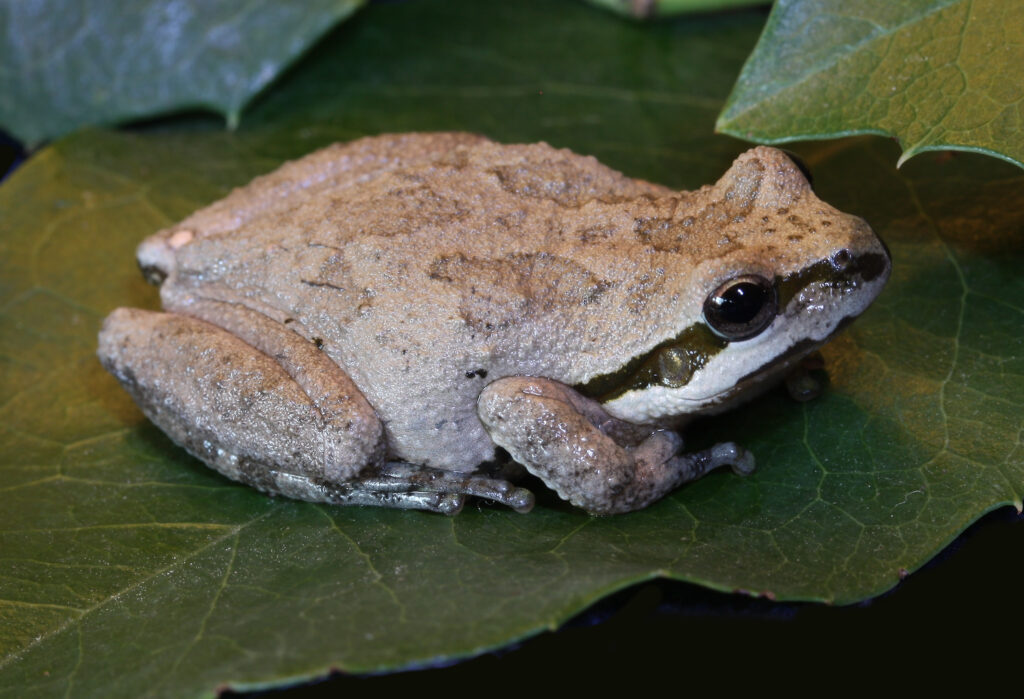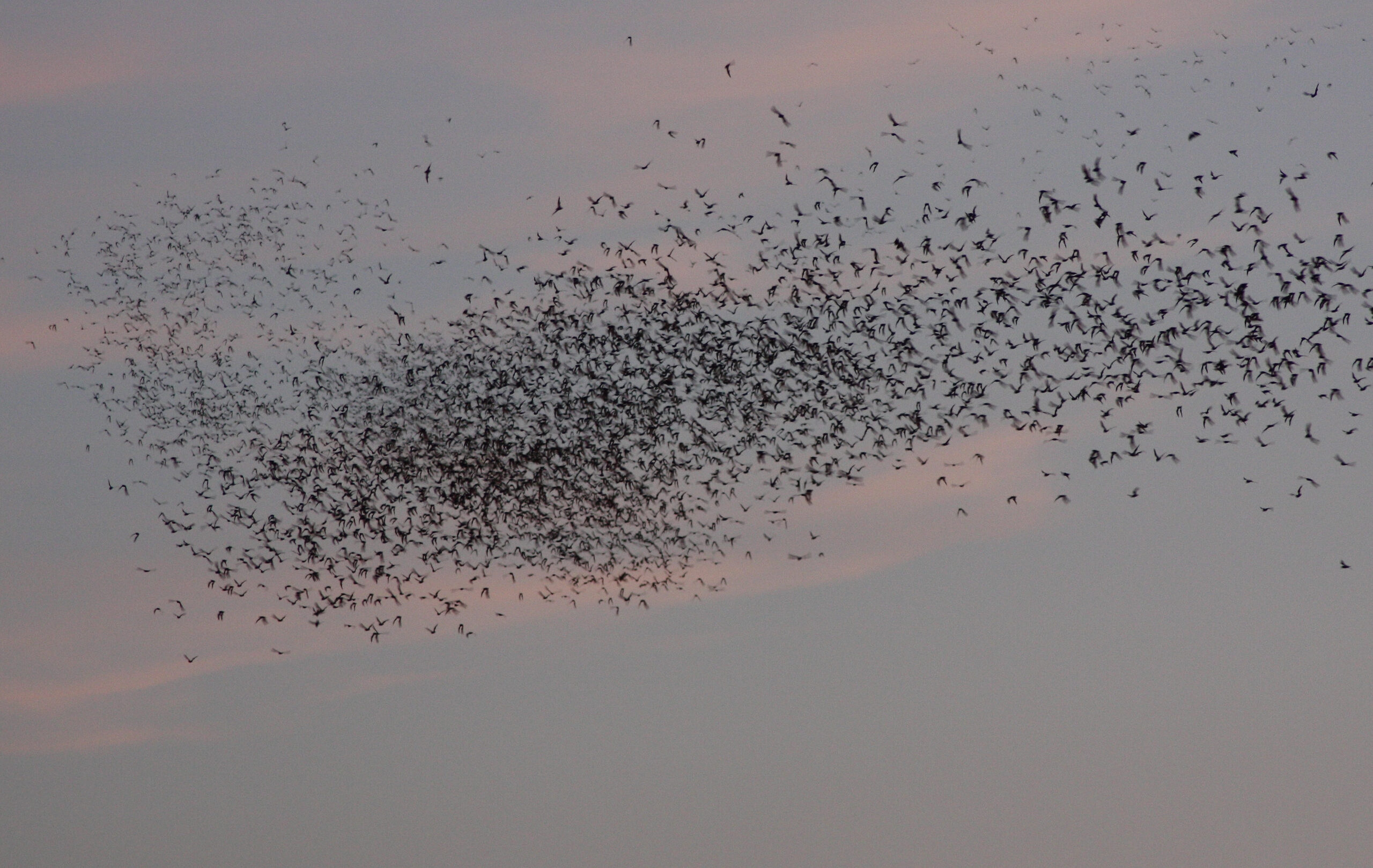Everyone is familiar with this frog by voice if not by sight. The well-known krek-ek call of the Pacific chorus frog has been used to complement an evening mood in countless Hollywood movies, especially those made in outdoor studio lots in southern California, where the call of the frog is naturally heard in the background. And it’s not uncommon to hear recorded calls of the Pacific chorus frog in movies made overseas, even though the frog’s home is limited to the western U.S.
The Pacific chorus frog is one to two inches in length. Its skin is smooth to slightly rough. The frog is typically brown or green, but it has the ability to slowly change from one color to the other. Whatever the skin color, the frog always has dark lines through its eyes. The inner thighs are yellow, which may cause a distracting flash of color when the frog jumps from a predator. Pads on its toes are not as pronounced as the toe pads of true treefrogs. Although it can climb vertical surfaces, the Pacific chorus frog is more at home along a waterway or in dense vegetation than in a tree. It probably should be considered a semi-aquatic ground-dwelling frog rather than an arboreal one. It eats a variety of invertebrates with its sticky tongue.

The Pacific chorus frog is apparently a complex of three species, although not everyone agrees. If it is a single species, the scientific name most commonly in use today is Pseudacris regilla. But in many studies, explained briefly below, evidence supports three species, Pseudacris hypochondriaca of southern California and Baja California, P. sierra of central California, including our area, and parts of Nevada, Idaho, and Montana, and P. regilla of northwestern California, Oregon, and Washington. These three species look identical, at least to our eyes. Let’s look at the long history of the contentious debate on Pacific chorus frog taxonomy. It’s full of twists and turns.
The frog genus Hyla was established in 1768 as a catch-all genus for frogs with pads on their toes for climbing (hence, they were collectively called treefrogs). Hyla regilla, the Pacific treefrog, was named in 1852. In 1966 Jameson named ten subspecies within H. regilla based on morphological traits, but it was still considered a single species. Case in 1975 conducted pioneering genetic work and discovered three lineages within the species. This was intriguing because three cryptic (hidden) species within H. regilla were suggested. In 1986 the Pacific treefrog was changed from the genus Hyla, the treefrogs, to Pseudacris, the chorus frogs, because Pseudacris species, including the Pacific chorus frog, breed in the winter and early spring (treefrogs breed late spring and summer), chorus frogs have smaller toe pads than treefrogs, and there are internal organ differences. Thus, the accurate common name for our frog is chorus frog, not treefrog (it’s not that into trees anyway). Recuero (2006) formally divided P. regilla into three species based on modern DNA methods, verifying the conclusions of Case. However, research was far from done. Using different DNA methodology, Barrow (2014) plainly concluded “Our results… do not support the species designations suggested by Recuero.” But two years later, Duellman not only supported the three species of Recuero, he moved the Pacific chorus frogs from Pseudacris to Hyliola, a new genus based largely on geography (Hyliola in the western U.S. and Pseudacris in the east). In yet another reversal, Banker in 2020 reclaimed the single species concept, explaining “splitting of this complex into three species … may have been premature,” and also rejected the genus move to Hyliola. But in the most recent paper, Jadin (2021) agreed with the split into three species and accepted Hyliola as the name for the genus. Phew!
Where are we now? Any name or names you choose to use must be considered tentative. Genetic data need to be augmented with descriptions of habitat, ecological role, and/or behavior of frogs from each lineage, which will help characterize the individuality of a species. For example, in frogs one of the first strategies to assure mating isolation, and thereby maintaining species separation, is the advertising call of male frogs. Females of each species only listen for and respond to mates of their own species. If there are differences in calls among the three putative species of Pacific chorus frogs, that would go a long way to convince people that the species separation is real. Alejandro Velez, Professor in the Department of Biology at San Francisco State University, is researching just that. He and his students may have results in a year or two.
The call we are familiar with is the male’s advertisement call, which consists of the two-part krek-ek (or ribb-it, if you prefer). This call attracts females as well as males, which work together to make a truly loud chorus to attract more females. Females seem to be attracted to males that make advertisement calls more frequently than other males. Males are territorial during the mating season and may use a slow trilling call, called the encounter call, to warn other males not to get too close. With a discerning ear you may be able to identify the different calls during breeding season. Males and females usually return to their home pond, creek, ditch, or wetlands to breed. During this time males have dark throats in contrast to the females’ white throats. Each female may lay hundreds of eggs in multiple small clusters. Tadpoles are deep brown to black but paler below. They feed on algae, bacteria, various protozoa, and organic debris until they metamorphose into adults in two to three months.
Although amphibians as a group are declining worldwide, populations of the Pacific chorus frog are thought to be stable. In suitable habitat, the frog is often abundant, even though local populations can fluctuate dramatically from year to year. Drought, non-native fish and bullfrogs, loss of habitat, pollution, and climate change are threats. In many locations in the world, frogs and other amphibians are threatened by infectious diseases like chytridiomycosis, which is caused by Batrachochytrium dendrobatidis, a type of fungus called a chytrid. Chytridiomycosis has caused the decline and possibly the extinction of many frogs worldwide, especially in cooler regions of New World tropics, like the cloud forests of Central and South America. The chytrid infects the skin of frogs, which is thin and sensitive to environmental change. In the Sierra Nevada, the chytrid is widespread among Pacific chorus frogs, which are resistant to infection and rarely show symptoms. However, the chorus frog acts as a carrier of the fungus, playing a role in the severe decline of the susceptible mountain yellow-legged frog. The bacterial community on the skin of the chorus frog apparently helps protect it from the disease. Perhaps the chorus frog holds other clues that explain why some species can cope with chytrid infections and other species succumb to the disease.




